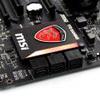Power Consumption and temperatures
Power Consumption and temperatures
Power consumption wise, AMD was able to keep the TDP of these FX processors, depending on model, at either 90W or 125W depending on your choice of processor. A higher power draw would result in unhappy customers, but obviously could also endanger heat levels. The processor is a pretty clever product when it comes to its power design and power states. Not only can the processor cores independently be throttled down, lowering voltage and what not, there are different power states inside the core allowing nearly complete shutdown of segments/domains. That makes the FX series flexible in terms of power gating versus power consumption and helps out in that everlasting denominator and worst enemy, heat.
In an IDLE state the PC (970 / FX 8370E) / 8GB memory / GeForce GTX 780 Ti / SSD) consumes 70 Watts.
When we place load on the CPU and we see the power draw rise, the system now consumes roughly ~160 Watts. This is with merely an SSD and 8GB memory and the GTX 780 Ti installed. Your average PC will draw a little more power if you add optical drives, HDDs, soundcards etc. Overclocked power consumption by added voltage we will deal with in another chapter of this article.
I want to make it very clear that power consumption measurements will differ per PC and setup. Your attached components use power but your motherboard can also have additional ICs installed like an audio controller, LUCID chips, network controllers, extra SATA controllers, extra USB controllers, and so on. These parts all consume power, so this is an indication. Next to that, we stress all CPU cores 100% and thus show a PEAK power consumption. Unless you transcode video with the right software your overall/average power consumption will be much lower.




